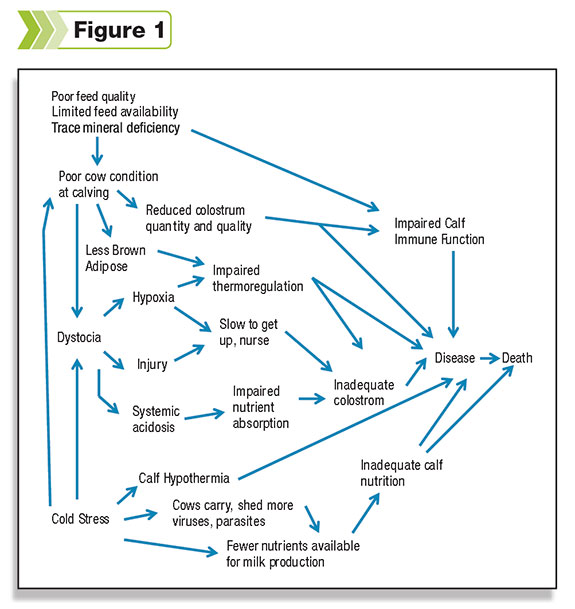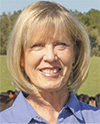These animals typically have subnormal body temperature and may be stained yellow at birth. Some look normal, or they may have scours or pneumonia; if treated, response is poor. Death loss is high.

“Perinatal calf mortality” is the scientific term for calf death during the first month of life, and the USDA estimates these losses at 2.5 million head annually. Across the industry, 5 to 6 percent is typical, but in a problem year, mortality can jump to 25 or even 50 percent.
In parts of the country, the stage has been set for a problem year. The primary risk factor for WCS is dystocia, or calving difficulty, followed by disease challenges.
Dystocia can contribute to WCS two ways: physical injury and exhaustion, and brain damage due to oxygen deprivation (“hypoxia”).
Drought during the forage growing season, plus severe winter weather at calving time, can combine to trigger a multi‐faceted cascade of events that puts calves at increased risk.
Here is one likely scenario: Drought‐stressed pastures provided inadequate nutrition to cows last summer. Harvested feeds needed to be fed for an extended period, but the diet continued to be suboptimum, limited by feed quality, availability and cost.
Poor body condition plus winter storms widened the gap between what was needed and what was supplied. Fetal development of the calves was altered, including reduced deposition of brown adipose tissue; this is normally metabolized to generate heat immediately after birth.
Cows became more susceptible to disease and parasites, further increasing unmet nutritional requirements. Deficiencies of trace minerals, especially copper, selenium and cobalt, set the stage for problems with mastitis, calf immunity and thermoregulation.
Thin, stressed cows have more calving difficulty and longer deliveries, resulting in injuries and hypoxia. The yellow coloring mentioned above comes from extended struggling in an environment contaminated with meconium (initial calf fecal material).
These cows also produce less, lower‐quality colostrum and milk, so their newborns get inferior immune protection and inadequate nutrition.
Because their own immune system is weakened by stress, the dams are more apt to carry infectious agents that can infect calves both before and after birth.
WCS is often associated with BVD and leptospirosis. During periods of cold stress, cows may also shed greater numbers of corona virus, contributing to calf scours.
Finally, WCS is more likely in aged cows, and recent high calf prices have induced some producers to keep older breeding animals in the herd “one more year.”
See the figure for a more visual depiction of events leading to WCS.
Obviously, we have calves entering the world with the odds stacked against them. When faced with a similar situation, or if calves are already exhibiting symptoms of WCS, key responses should include:
- Check calving cows frequently and provide shelter as needed (and practical)
- Step in and assist with births after as little as one to one and a half hours of unproductive effort
- Dry newborn calves immediately and do all you can to keep them dry
- Be sure all calves receive adequate colostrums (2 quarts within six hours of birth, 2 more within 12)
- Ensure calves receive adequate nutrition beyond this initial period
- Minimize disease exposure, from both the environment and other animals
- Evaluate potential need for supplemental vitamins or trace minerals for cows or calves
In the big picture, the focus needs to be on long‐term prevention. Cows need adequate, balanced diets through all of pregnancy and lactation.
In one study, calves of heifers that were protein‐restricted during late gestation took half again as long to stand and suckle, and their mothers only produced 72 percent as much colostrums as properly fed herd mates.
Even when conditions are challenging and feed prices high, the value of preventing early calf sickness and death losses is likely far greater than the cost of the extra feed needed to get there. ![]()
—From Quality Control Feeds CattleSense e-newsletter
Figure courtesy of QLF.






